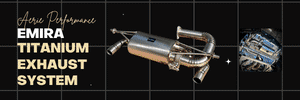First DIY oil/filter change at 1850 km. My thanks to everyone posting above on this thread. I referred to everyone’s advice.
I backed onto my usual ramp system, which increased the gap below the car, by 1.5”, over the gap created using just the black ramps.
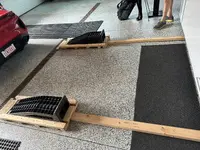
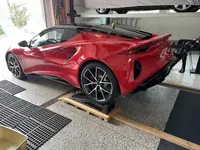
I don’t recommend this system for a mid-engine vehicle. It raises the Emira too high, so I had to get in the trunk to access the oil filler and dipstick, which was awkward. I have a 4-post lift but once my winter car is parked on top, I don’t use it for servicing. I’ll likely change that practice in future, to change the Emira oil. IMO, just using the ramps alone, would be too difficult (not roomy enough) trying to work under the Emira, with all the protective under plate bolts that have to come out.
I used a 14mm wrench to remove the drain plug, which for me worked better than a ratchet. Like others, getting the washer off the drain pan, was a challenge. But perseverance with a small flat head screwdriver, did the trick.
The bolts are 7mm, 10mm (sockets) and for the diffuser smaller bolts, I used a 4mm hex bit.
Not all bolts on the diffuser have to be removed. Someone mentioned removing only the bolts on the aluminum plate next to the diffuser (silver plate closer to the front), and none from the black diffuser, but I didn’t think that possible. After removing all the aluminum plate bolts and the bolts in common to both the aluminum plate and the diffuser (on the edge where they join), you need to remove 2 smaller 4mm bolts, which are on the next row (from the aluminum plate/diffuser edge, so the row closer to the rear of the vehicle) on the diffuser itself. These 2 bolts secure the diffuser tightly to the underbody and if left in, prevent you from dropping down the diffuser edge far enough, to wiggle the aluminum plate out. At least that’s how it worked for me. The 2 bolts to remove, are the second ones in from the edge, on each side. See photos showing them removed on each side:
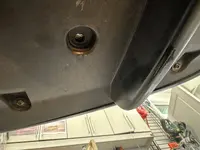
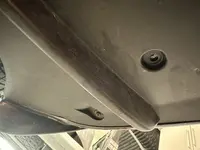
I removed nineteen 10mm bolts (3 of them found below 1.5” rubber grommets), fourteen 7mm bolts/washers, and two 4mm bolts/washers. I actually removed more 4mm bolts/washers in the beginning, until I figured out only 2 were necessary, so I put the others back in before buttoning everything up.
This photo shows what I felt necessary to remove (bolts/grommets):
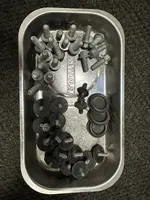
I plugged in a tube to the oil filter housing, planning to drain most of the oil out of the filter before removing it entirely (avoiding a drippy mess). BUT it didn’t work well for me so there was still a fair bit of oil left in the filter. The photos below show the tube; the first with the threaded bottom in the “off position” and showing the filter wrench I used, and the second with it threaded up, to open the valve and allow drainage from the filter:
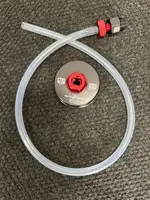
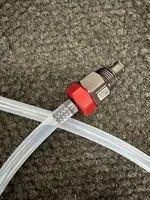
Figuring out the amount of oil to put in was fun. The Service Manual p. 40-68 states: “service full volume 5 litres; dry fill volume 6 litres”. That’s litres and NOT US quarts, with 6 US quarts equaling 5.6781 litres. So presumably only 5 litres (just over 5 quarts) is needed. That’s far less than the 6 US quarts others mentioned putting in. Anyway, after parking my vehicle for an hour (not ideal I know, but I left my garage to find a level spot), I put in just under 5.3 litres, which brought the oil level to 3/4 up the 2 marks on the dipstick (I put in just under 5 litres in my garage, then later slowly topped up the rest). It may be that having the Emira up so high on my ramp system, prevented oil from draining. I put in the same new oil, compared to what came out. But the Service Manual says what it says. I suppose getting to the very top of the fill level, may have been 6 US quarts, which looks to disagree with the Service Manual.
One has to be careful trying to read the oil on the dipstick, since it’s such a light/clear oil when new.
For the oil funnel, I used a combo: the Lisle right angle funnel, inserted into the Toyota threaded tube end, which I screwed onto the engine oil filler. It worked great and I could prop up and drain a 5 litre plastic oil container, into the Lisle, by putting the container against the rear window glass. Photo below shows the Lisle and the threaded end used. It also shows the original blue funnel that came attached to the threaded end. It wasn’t usuable since it stuck up too high and hit the glass window.
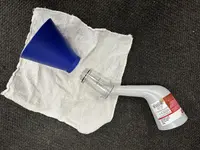
Hope this adds to the discussion and is helpful.














